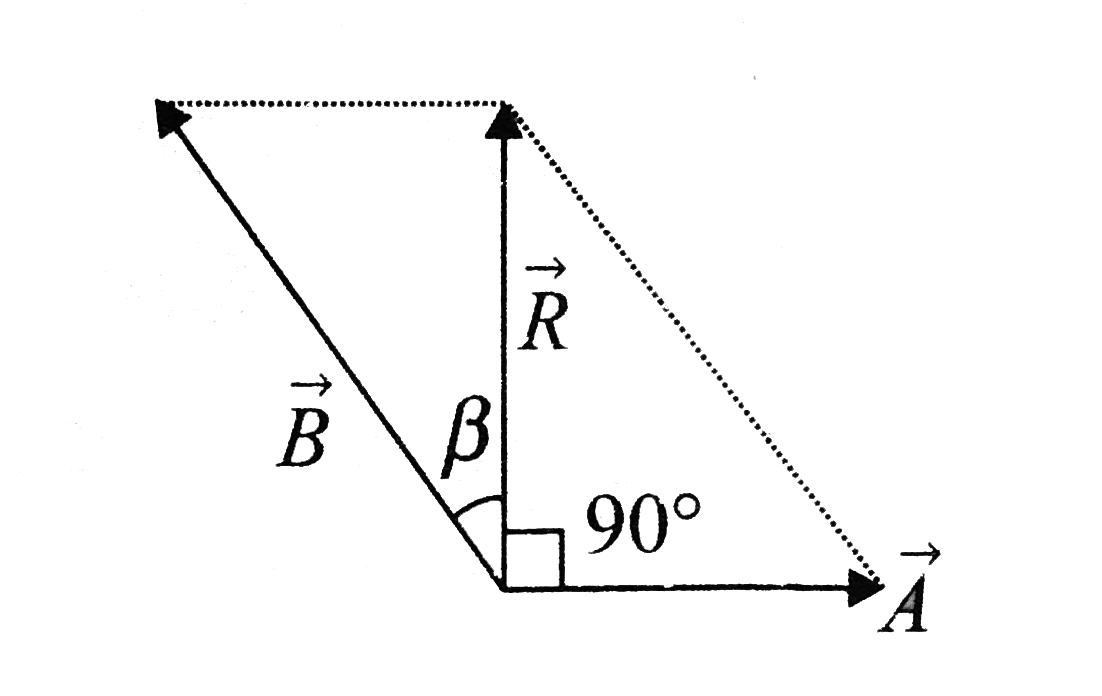the resultant of two vectors →a&→b is perpendicular to →a. If ∣∣→b∣∣=√2|→a| show that the resultant of 2→a&→b is perpendicular to →b .
To solve the problem step by step, we will follow the logical deductions based on the properties of vectors and their dot products.
Step 1: Understand the Given Information
We are given two vectors, →a and →b, such that the resultant →R=→a+→b is perpendicular to →a. This means:
→R⋅→a=0
Step 2: Use the Dot Product Condition
Since →R=→a+→b, we can express the dot product condition as:
(→a+→b)⋅→a=0
Expanding this gives:
→a⋅→a+→b⋅→a=0
Let |→a|2=→a⋅→a and →b⋅→a=x. Thus, we have:
|→a|2+x=0⟹x=−|→a|2
This implies:
→b⋅→a=−|→a|2
Step 3: Use the Magnitude of →b
We are also given that |→b|=√2|→a|. Therefore:
|→b|2=2|→a|2
This means:
→b⋅→b=2|→a|2
Step 4: Show that the Resultant of 2→a and →b is Perpendicular to →b
We need to show that the resultant →R′=2→a+→b is perpendicular to →b:
(2→a+→b)⋅→b=0
Expanding this gives:
2→a⋅→b+→b⋅→b=0
Substituting the values we found earlier:
2(−|→a|2)+2|→a|2=0
This simplifies to:
−2|→a|2+2|→a|2=0
Thus, we have:
0=0
This confirms that 2→a+→b is indeed perpendicular to →b.
Conclusion
We have shown that the resultant of 2→a and →b is perpendicular to →b.
We are given two vectors, →a and →b, such that the resultant →R=→a+→b is perpendicular to →a. This means:
→R⋅→a=0
Since →R=→a+→b, we can express the dot product condition as:
(→a+→b)⋅→a=0
Expanding this gives:
→a⋅→a+→b⋅→a=0
Let |→a|2=→a⋅→a and →b⋅→a=x. Thus, we have:
|→a|2+x=0⟹x=−|→a|2
This implies:
→b⋅→a=−|→a|2
We are also given that |→b|=√2|→a|. Therefore:
|→b|2=2|→a|2
This means:
→b⋅→b=2|→a|2
We need to show that the resultant →R′=2→a+→b is perpendicular to →b:
(2→a+→b)⋅→b=0
Expanding this gives:
2→a⋅→b+→b⋅→b=0
Substituting the values we found earlier:
2(−|→a|2)+2|→a|2=0
This simplifies to:
−2|→a|2+2|→a|2=0
Thus, we have:
0=0
This confirms that 2→a+→b is indeed perpendicular to →b.
We have shown that the resultant of 2→a and →b is perpendicular to →b.
Topper's Solved these Questions
- VECTOR BOOK - MOTIONCHAPTER - VECTOR EXERCISE - EXERCISE - 4 ( LEVEL -I)
36 Videos
- VECTOR BOOK - MOTIONCHAPTER - VECTOR EXERCISE - EXERCISE - 4 ( LEVEL-II)
41 Videos
- VECTOR BOOK - MOTIONCHAPTER - VECTOR EXERCISE - EXERCISE - 2 ( LEVEL -II)
15 Videos
- TRIGONOMETRIC EQUATIONBOOK - MOTIONCHAPTER - TRIGONOMETRIC EQUATIONEXERCISE - EXERCISE 4
10 Videos
Similar Questions
Knowledge Check
The vectors →a and →b are perpendicular if :
A→a.→b=0B→a.→b≠0C→a×→b=→0D→a×→b≠→0The resultant of →Aand→B is perpendicular to →A. What is angle between →Aand→B ?
Acos−1(AB)Bcos−1(−AB)Csin−1(AB)Dsin−1(−AB)Given that →A+→B=→C and that →C is perpendicular to →A Further if ∣∣→A∣∣=∣∣→C∣∣, then what is the angle between →A and →B
Aπ4radB3π4radC5π4radD7π4rad
If →a and →b are perpendicular vectors, ∣∣→a+→b∣∣=3 and |→a|=5, find the value of ∣∣→b∣∣.
View SolutionIf →a and →b are perpendicular vectors such that ∣∣→a+→b∣∣=13and|→a|=5, find the value of ∣∣→b∣∣.
View SolutionThe resultant of two velocity vectors →A and →B is perpendicular to →A. Magnitude of Resultant →R is equal to half magnitude of →B. If the angle between →A and →B is (30θ)∘, then value of θ is ?
View SolutionThe resultant of two vectors →A and →B is perpendicular to the vector →A and its magnitudes is equal to half of the magnitudes of vector →B (figure). The angle between →A and →B is

View SolutionThe vector (→a+3→b) is perpendicular to (7→a−5→b) and (→a−4→b) is perpendicular to (7→a−2→b). The angle between →a and →b is :
View Solution
